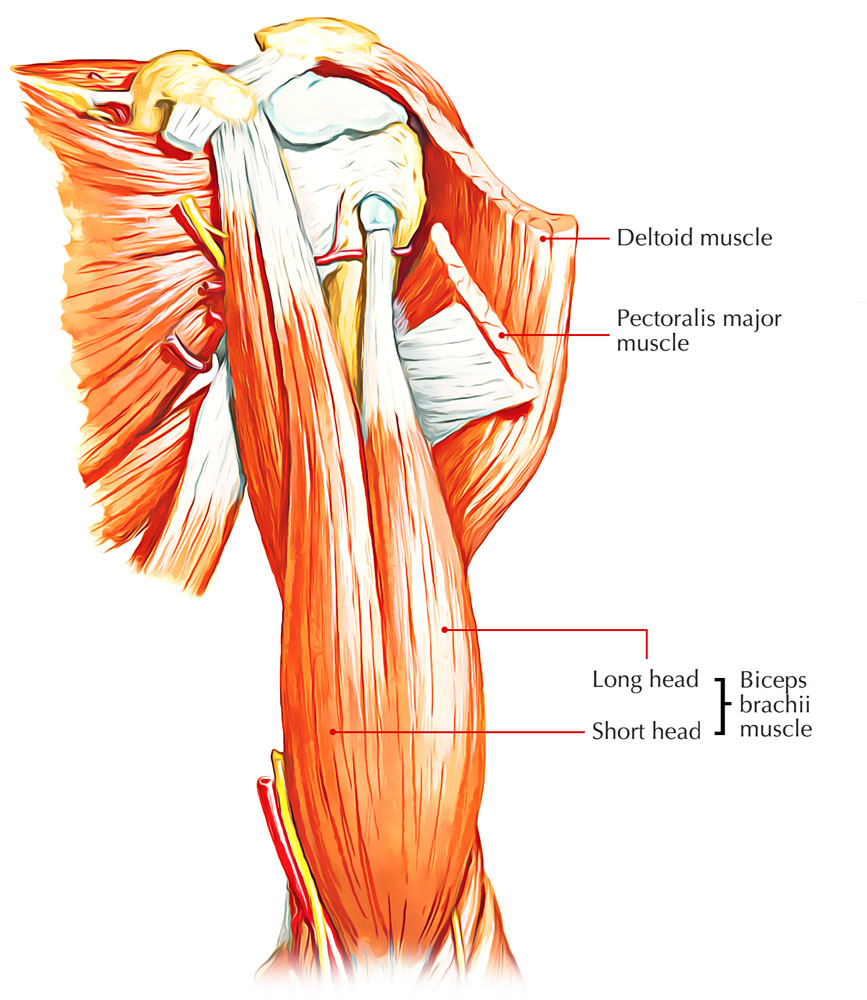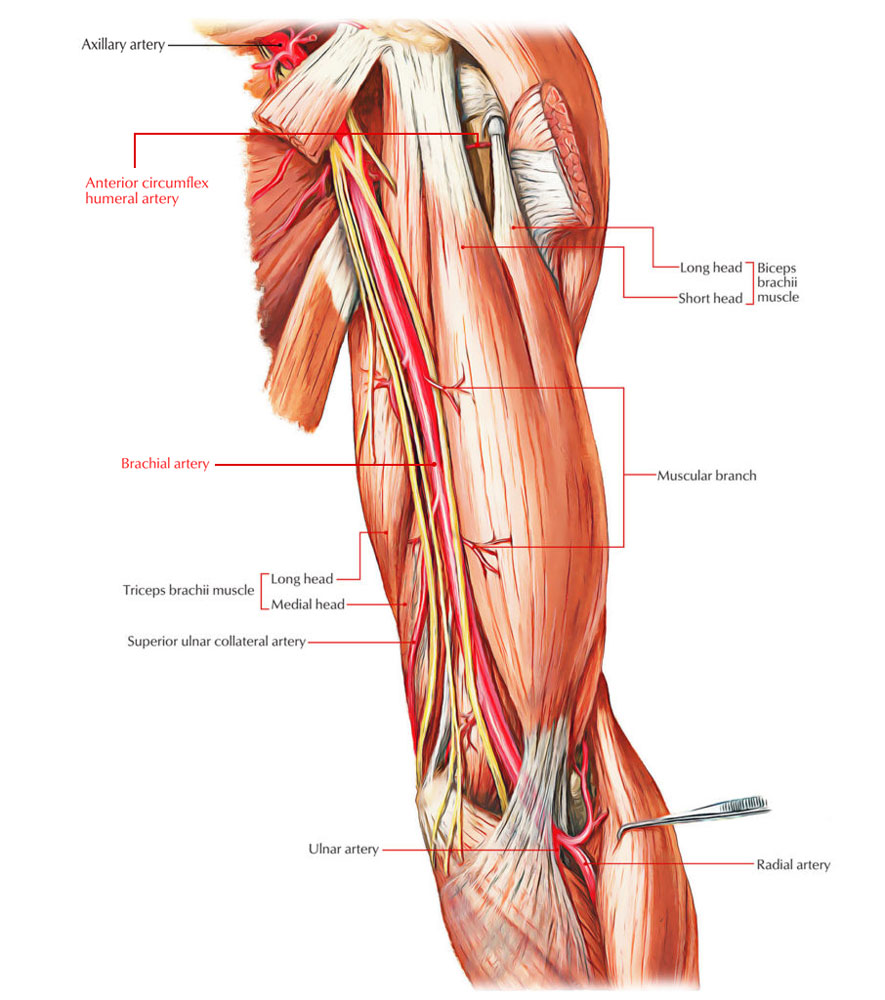Biceps Brachii is a two-headed single muscle which is located on the upper arm in between the shoulder and the elbow. The fusiform fleshy belly of the biceps is divided into a long and a short head.
Origin of Biceps Brachii

Biceps Brachii Muscle
The biceps brachii muscle emerges from the scapula by two heads: long and short:
- Long head occurs from supraglenoid tubercle within the capsule of the shoulder joint. Its tendon goes on above the head of the humerus and arises from the joint through intertubercular sulcus.
- Short head occurs in addition to coracobrachialis from the tip of the coracoid process.
The two heads collaborate in the distal third of the arm to form a belly that ends in a tendon, which produces the bicipital aponeurosis from its medial facet, opposite the bend of the elbow.
Insertion of Biceps Brachii
The biceps brachii muscle is inserted into:
- The posterior component of the radial tuberosity by its tendon. A bursa steps in between the tendon and anterior part of the tuberosity, and
- The deep fascia on the medial element of the forearm by its aponeurosis (bicipital aponeurosis). The aponeurosis safeguards the underlying brachial artery and median nerve.
Structure of Biceps Brachii
The complete biceps brachii muscle extends from the shoulder to the elbow. Arising from the under the pectoralis significant, the belly broadens into its familiar bulging shape and ends quickly into a really strong, narrow tendon. This tendon inserts deep in the elbow in between the extensor and flexor masses of the forearm.
The front profile of the biceps brachii (seen in side view) is straight for a significant length when the elbow is extended, however, ends up being rather rounded and bulging when the elbow is totally bent. The deep posterior surface of the belly of the biceps is flattened where it is located on the brachialis. The separation in between the heads, which sometimes might extend all the way down the belly, is normally not really noticable. The various attributes of the two bellies are seen at the upper end of the belly when the elbow is completely bent– the long head is fuller, much more rounded, and directed towards the head of the humerus, while the short head is more lengthen and directed towards the underarm.
At the inferior end of the biceps brachii muscle, the fibers at the medial side of the belly came down lower than those of the lateral side. The medial portion of the belly might be even more divided longitudinally, forming a narrow, lengthened muscle slip on its severe medial edge. This is not the separation in between the medial and lateral heads.
Relationship of Biceps Brachii to other Structures
- Proximally, the biceps brachii is deep to the deltoid and deep to the distal tendon of the pectoralis significant. The rest of the biceps brach is superficial.
- From an anterior point of view, the brachialis is located deep to the biceps brachii.
- The short head of the biceps brachii is located lateral to the coracobrachialis.
- The proximal attachment of the short head of the biceps brachii is the coracoid procedure of the scapula. The coracobrachialis and the pectoralis small likewise connect to the coracoid procedure.
- The long head of the biceps brachii routes through the bicipital groove of the humerus. The long head of the biceps brachii after that courses through the joint cavity of the glenohumeral joint; for that reason it is intra-articular.
- Straight medial to the belly and distal tendon of the biceps brachii are the brachial artery and the median nerve.
- The bicipital aponeurosis is superficial to the common flexor tendon, and does not connect into the bone.
- The biceps brachii lies within the deep front arm line and involved along with the superficial front arm line myofascial meridians.
Nerve supply of Biceps Brachii
Biceps brachii muscle is supplied by musculocutaneous nerve (C5, C6, and C7).
Arterial supply of Biceps Brachii

Biceps Brachii Muscle – Arterial Supply
The biceps brachii muscle is supplied by two arteries:
- The muscular branches of the Brachial Artery (the extension of the Axillary Artery).
- The Anterior Circumflex Humeral Artery (a branch of the Axillary Artery).
Actions of Biceps Brachii
Biceps Brachii muscle performs the following actions:
- It’s a strong supinator of the forearm, when the elbow is bent. This action is made use of in screwing movements like tightening up the screw with a screw driver.
- It’s a powerful flexor of the forearm, when the elbow is extended.
- It’s likewise a weak flexor of the shoulder joint.
Essential Mover Actions
- Bends the forearm at the elbow joint.
- Supinates the forearm at the radioulnar joints.
- Bends the arm at the glenohumeral joint.
- Abducts the arm at the glenohumeral joint (long head).
- Adducts the arm at the glenohumeral joint (short head).
- Horizontally bends the arm at the glenohumeral joint.
Reverse Mover Actions
- Bends the arm at the elbow joint.
- Supinates the ulna at the radioulnar joints and medially turns the arm at the glenohumeral joint.
- Upwardly turns the scapula at the glenohumeral joint and scapulocostal joint.
- Downwardly turns the scapula at the glenohumeral joint and scapulocostal joint.
- Downwardly turns and laterally tilts the scapula at the glenohumeral joint and scapulocostal joint.
- Extends the scapula at the glenohumeral joint and scapulocostal joint.
Eccentric Antagonist Functions
- Restrains/slows elbow joint extension.
- Restrains/slows radioulnar joints pronation.
- Restrains/slows arm extension, horizontal extension, adduction, abduction, and lateral rotation.
- Restrains/slows scapular upward rotation, downward tilt, medial tilt, and retraction.
Isometric Stabilization Functions
- Supports the elbow, radioulnar joints, and glenohumeral joint.
- Supports the scapula.
Clinical Testing of Biceps Brachii
The biceps brachii is evaluated by asking the patient to bend the elbow against resistance while the forearm is supinated. Here in this act, the muscle makes up a prominent bulge on the front of the arm.
Clinical Significance of Biceps Brachii
Biceps reflex
It is checked throughout physical checkup by tapping the tendon of biceps brachii by a reflex hammer with forearm pronated and partly extended at the elbow. The regular reflex is quick jerk-like flexion of the elbow. The regular reflex verifies the stability of musculocutaneous nerve and C5 and C6 spinal segments.
Rupture of the biceps tendon
It is pretty uncommon for muscles and their tendons to rupture in the upper limb; nevertheless, the tendon that the majority of frequently ruptures is the tendon of the long head of the biceps brachii muscle. In isolation, this has reasonably little effect on the upper limb, however, it does create a particular deformity-on flexing the elbow, certainly, there is an exceptionally prominent bulge of the muscle belly as its unrestrained fibers contract the “Popeye” sign.

 (59 votes, average: 4.58 out of 5)
(59 votes, average: 4.58 out of 5)